back to
homepage & photographs
Page 1. I
2. I
3. I
4. I
5. I
6. I
Tasks
1.British K class submarines
This is a modified article from Wikipedia, the free encyclopedia
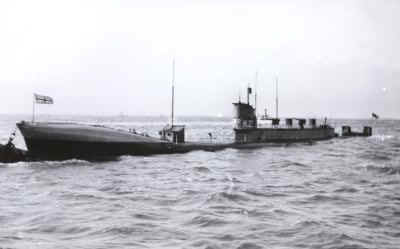 HMS Submarine K22 (ex K13) 1920. |
|
| K class |
|
|---|---|
| General Characteristics (except K26) | |
| Displacement: | 1,980 tons surfaced/2,566 tons dived |
| Length: | 339 ft (103 m) |
| Beam: | 26 ft 6 in (8.08 m) |
| Draught: | 20 ft 11 in (6.38 m) |
| Propulsion: | Twin 10,500 shp (7.8 MW) oil-fired Yarrow boilers
each powering a Brown-Curtis or Parsons geared steam
turbines, Twin 3 blade 7 ft 6 in (2.29 m)
screws Four 1,440 hp (1.074 MW) electric motors. One 800 hp (0.6 MW) Vickers diesel generator for charging batteries on the surface. |
| Speed: | 24 knots (44 km/h) surfaced/8 knots (10 km/h) dived |
| Range: | Surface: 800 nautical miles (1,500 km) at maximum
speed, 12,500 miles at 10 knots (20,000 km at 19 km/h) Dived: 8 nautical miles at 8 knots (10 km at 10 km/h), 40 miles at 4 knots (64 km at 7 km/h) |
| Complement: | 59 (6 officers and 53 ratings) |
Armament 
|
Four 18 inch (460 mm) beam torpedo tubes, four 18 inch (460 mm) bow tubes, plus 8 spare torpedoes, two 4 inch (100 mm) guns, one 3 inch (80 mm) gun. Twin 18 inch |
The K class submarines were a class of steam-propelled submarines of the Royal Navy designed in 1913. Intended as large, fast vessels which had the endurance and speed to operate with the battle fleet, they gained notoriety, and the nickname of Kalamity class, for being involved in many accidents. Of the 18 built none were lost through enemy action but 6 sank in accidents. Only one ever engaged an enemy vessel, hitting a U-boat amidships with a torpedo which failed to explode.
In 1913 an outline design was prepared for a new submarine class which could operate with the fleet, sweeping ahead of it in a fleet action. At that time only way which they could have sufficient surface speed, of 24 knots (44 km/h), to keep up with fleet was to be steam powered.
So to make them fast enough, the K Class submarines had oil-fired boilers. These boiled water to produce steam which powered geared steam turbines. The turbines turned the propellers (screws), which propelled the submarine. But because the submarines used oil fuel burning boilers, they then needed twin funnels or chimneys. These would fold over and be covered by water proof lids, when the submarine wanted to dive under the water!
Also, so that the oil fired boilers and diesel generators had the oxygen needed to burn, the submarines had air intake vents or holes. These also needed to be closed with air tight lids when the submarine dived.
The K class boats were to be 338 ft (103 m) long and displace 1700
tons on the surface.
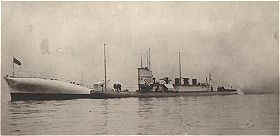
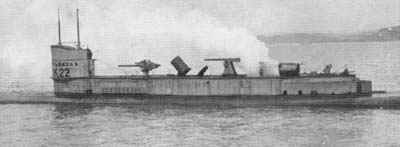
HMS Submarine K22 (ex K13) 1920.

Submarine K5, sunk with the loss of
all hands in the English Channel.
Six improved versions, K22 to K28 were ordered in October 1917 but the end of the First World War meant that only K26 was completed.
The double hull design (two layers of 'skin') had a reserve of buoyancy of 32.5 percent (a modern nuclear submarine has a reserve of around 13 percent). Although powered on the surface by oil-fired steam turbines, they were also equipped with an 800 hp (0.6 MW) diesel generator to charge the batteries and provide limited propulsive power in the event of problems with the boilers.
They were equipped with four 18 inch (460 mm) torpedo
tubes at the bow,
two on either beam and another pair in a swivel mounting on the
superstructure for night
use. The swivel pair were later removed because they were prone to
damage in rough seas.
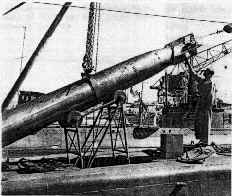 Loading
torpedos.
Loading
torpedos.
They were fitted with a proper deckhouse built over and around the conning tower which gave the crew much better protection than the canvas screens which had been fitted in all previous Royal Navy submarines.
The great size of the boats compared to their predecessors led to
control and depth keeping problems particularly as efficient telemotor
controls had not yet been developed. This was made worse by the
estimated maximum diving depth of only 200 ft (60 m) being much
less than their length, of 339 ft (103 m). This meant that whilst the bow would almost on the surface, the stern
would almost be at its maximum safe depth. The problems were made even
more dangerous because the eight internal bulkheads
were designed and tested during development to stand a pressure
equivalent to only 70 ft (20 m)!
K3 was the first of the class to be completed, in May 1916 and trials showed numerous problems. The most serious was the high temperatures in the boiler room which was to some extent alleviated by installing bigger fans.
Steaming at speed tended to push the bow down into the water making the
already poor sea-keeping worse. To fix this a bulbous swan bow
was added. (See the picture above of the K5 .) Nevertheless there were still problems, the most embarrassing
being that in a heavy sea water could enter the boat through the twin funnels
(chimneys) and put the boiler
fires out!
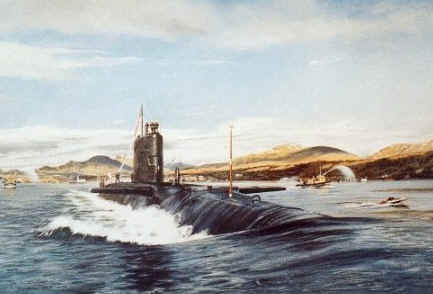 A later Class Sub.
A later Class Sub.
They suffered numerous accidents, largely caused by their poor manouverability coupled with operating with the surface fleet, and which caused the loss of the following:
- K13 sank on 19 January 1917 during sea trials when an air intake lid failed to close whilst diving and her engine room flooded. She was eventually salvaged and recommissioned as K22 in March 1917.
- K1 collided with K4 off the Danish coast on 18 November 1917 and was scuttled (deliberately sunk) to avoid capture by the enemy (Germans).
- Two boats were lost in an incident known as the "Battle" of May Island on 31 January 1918. The cruiser HMS Fearless collided with the head of a line of submarines, K17, which sank in about 8 minutes, whilst other submarines behind her all turned to avoid her. K4 was struck by K6 which almost cut her in half, and was then struck by K7 before she finally sank with all her crew. At the same time K22 (the rebuilt, recommissioned K13) and K14 collided although both survived. In just 75 minutes, two submarines had been sunk, three badly damaged and 105 crew killed.
- K5 was lost due to unknown reasons during a mock (pretend) battle in the Bay of Biscay on 20 January 1921. Nothing further was heard of her following a signal that she was diving, but wreckage was recovered later that day. It was concluded that she exceeded her safe maximum depth.
- K15 sank at her mooring (where she was tied up) in Portsmouth on 25 June 1921. This was caused by hydraulic oil expanding in the hot weather and contracting overnight as the temperature dropped and the consequent loss of pressure causing diving vents to open. The boat flooded through open hatches as it submerged.
Dive time was around 5 minutes, with the record being 3 minutes 25 seconds which was claimed by K8. The leisurely time allowed the captain the luxury of being able to walk around the superstructure to ensure that the funnels (chimneys) were securely folded down.
The last, improved, boat, K26 was completed slowly, finally being commissioned in 1923. She had six 21 inch (530 mm) bow torpedo tubes but retained the 18 inch (460 mm) beam tubes. Her higher casing almost cured the problems of seawater entering the boiler room and improved ballast tank arrangements cut the diving time to 3 minutes 12 seconds to get to 80 ft (24 m). She also had an increased maximum diving depth of 250 ft (75 m).
 A
later Class Sub.
A
later Class Sub.
Most were scrapped between 1921
and 1926
but K26 survived until 1931,
only being broken up because her displacement exceeded the limits for
submarine displacement in the London
Naval Treaty of 1930.
Although the concept of a submarine fast enough to operate with a battle fleet eventually fell out of favour, it was still an important consideration in the design of the Thames class in the late 1920s.
The K Class was an attempt to build a
submarine to operate with surface fleets, but it suffered a large number
of accidents and was described as "the result of an unholy union
between a destroyer and a submarine".
References
- DK Brown, The Grand Fleet, warship design and development 1906–1922,
- Preston, Antony, World's Worst Warships, Conway's Maritime Press, 2002,
- RN
Submarine museum
Top www.interactive-learning.com.au
